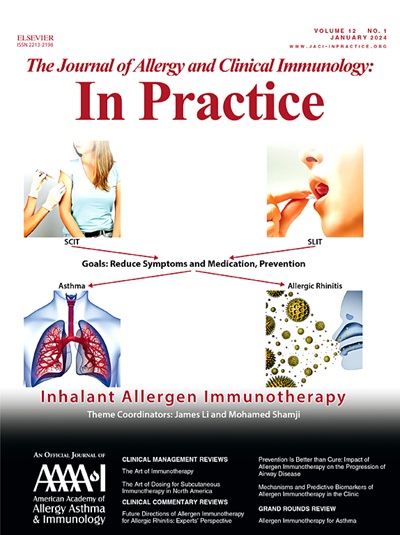气候变化和过敏原:当前和未来的影响。
IF 8.2
1区 医学
Q1 ALLERGY
Journal of Allergy and Clinical Immunology-In Practice
Pub Date : 2025-06-01
DOI:10.1016/j.jaip.2025.02.039
引用次数: 0
摘要
气候变化将继续以直接和间接的方式影响过敏性疾病。全球气温上升导致花粉季节持续时间延长,空气过敏原的产生和效力改变,以及致敏植物地理分布的变化,导致人类暴露于空气过敏原和过敏性疾病发病率增加。气候变化与空气污染有着千丝万缕的联系,后者被证明是过敏性炎症过程的辅助剂,促进了过敏性致敏。接触污染物还与儿童哮喘的高患病率以及现有哮喘和过敏性疾病的恶化有关。由于气候变化,空气过敏原和空气污染的暴露或共同暴露增加将导致更高的致敏率,而过敏性疾病的发生率仍不确定。包括儿童、老年人和边缘群体在内的弱势群体可能会受到不成比例的影响。本文综述了气候变化对空气过敏原以及变应性疾病影响的现有知识。应对这些健康挑战需要全面了解气候变化、过敏原、污染和公共卫生之间的相互作用,同时采取积极措施减轻这些影响。本文章由计算机程序翻译,如有差异,请以英文原文为准。
Climate Change and Allergens: Current and Future Impacts
Climate change will continue to impact allergic diseases in direct and indirect ways. Rising global temperatures are contributing to increased duration of pollen seasons, altered aeroallergen production and potency of allergens, and changes in the geographic distribution of allergenic plants that drive increased human exposure to aeroallergens and increased allergic disease morbidity. Climate change is inextricably linked with air pollution, the latter of which was shown to act as an adjuvant for allergic inflammatory processes promoting allergic sensitization. Pollutant exposure is also linked with higher prevalence of childhood asthma and exacerbation of existing asthma and allergic disease. Increased exposure, or co-exposure, to aeroallergens and air pollution as a result of climate change will result in higher rates of sensitization, and incident allergic disease remains uncertain. Vulnerable populations, including children, the elderly, and marginalized groups, are likely to be disproportionately affected. This review summarizes the current knowledge of the effects of climate change on aeroallergens, and by extension, allergic disease. Addressing these health challenges requires a comprehensive understanding of the interaction between climate change, allergens, pollution and public health, alongside proactive measures to mitigate these effects.
求助全文
通过发布文献求助,成功后即可免费获取论文全文。
去求助
来源期刊

Journal of Allergy and Clinical Immunology-In Practice
ALLERGYIMMUNOLOGY-IMMUNOLOGY
CiteScore
11.10
自引率
9.60%
发文量
683
审稿时长
50 days
期刊介绍:
JACI: In Practice is an official publication of the American Academy of Allergy, Asthma & Immunology (AAAAI). It is a companion title to The Journal of Allergy and Clinical Immunology, and it aims to provide timely clinical papers, case reports, and management recommendations to clinical allergists and other physicians dealing with allergic and immunologic diseases in their practice. The mission of JACI: In Practice is to offer valid and impactful information that supports evidence-based clinical decisions in the diagnosis and management of asthma, allergies, immunologic conditions, and related diseases.
This journal publishes articles on various conditions treated by allergist-immunologists, including food allergy, respiratory disorders (such as asthma, rhinitis, nasal polyps, sinusitis, cough, ABPA, and hypersensitivity pneumonitis), drug allergy, insect sting allergy, anaphylaxis, dermatologic disorders (such as atopic dermatitis, contact dermatitis, urticaria, angioedema, and HAE), immunodeficiency, autoinflammatory syndromes, eosinophilic disorders, and mast cell disorders.
The focus of the journal is on providing cutting-edge clinical information that practitioners can use in their everyday practice or to acquire new knowledge and skills for the benefit of their patients. However, mechanistic or translational studies without immediate or near future clinical relevance, as well as animal studies, are not within the scope of the journal.
 求助内容:
求助内容: 应助结果提醒方式:
应助结果提醒方式:


